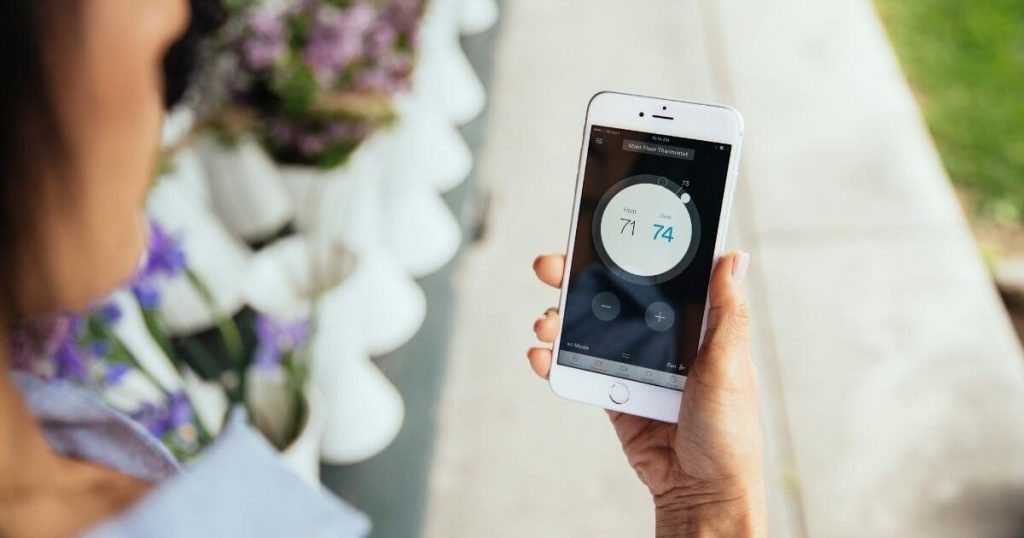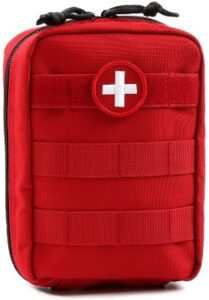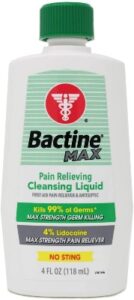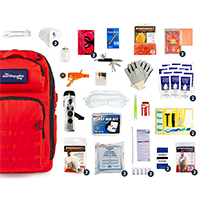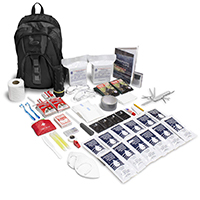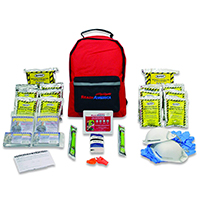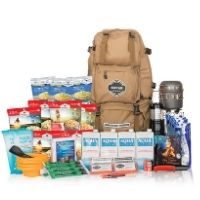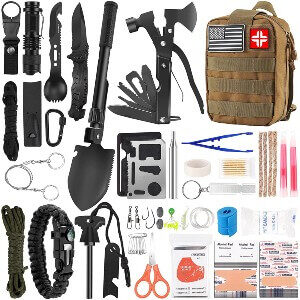Reviewed by health expert Sally Russell, MN, CMSRN, CNE
8 Essentials for Your DIY First Aid Kit
For over 11 years, SafeWise experts have conducted independent research and testing to write unbiased, human reviews (not robots). Learn more.
Every year, unintentional injuries result in millions of medical visits.1 Thankfully, if you’re prepared, many common, mild injuries can be treated with a few medical essentials at home.
You can purchase a ready-made first aid kit or a pre-made emergency survival kit, but it’s also easy to assemble your own emergency kit and personalize it to your family’s needs. When putting together your first aid kit, make sure you have the following eight essential items.
1. Containers
Amazon.com list price as of post date. Read full disclaimer.
The first thing you need is a water-resistant container to hold everything. You may want a soft pouch with multiple compartments to keep your items organized. You can reuse a backpack or purchase a first aid bag.
One of the most popular options is the Orca Tactical MOLLE EMT utility pouch, which features elastic straps, a drawstring bag, and a spacious pocket for smaller supplies.
Along with this primary container, you may also need plastic bags and pill bottles to hold small items and a marker to label them.
2. Personal items
Keep a list of emergency phone numbers, including those for doctors, dentists, local hospitals, and important family contacts. If you or a family member takes medication or requires insulin, keep a few doses in your kit, along with a cooler travel case (keep the cold packs in the freezer so they're ready to go when you need them). If you run out of your prescription or can’t make it to the pharmacy, you’ll have a backup supply at home.
A few tips for keeping medications in your emergency kit:
- Keep prescriptions in their original containers so you have all pertinent information on hand, including dosages, warnings, and pharmacist contact details.
- Regularly check the expiration date of medications and replace as needed. Some need to be replaced every six months.
- If you are storing insulin, keep it in a cool place. You can even pin a sticky note to the outside of your kit to remind you to grab insulin from the fridge so it's not forgotten in your rush out the door, along with your cold packs in the freezer.
3. Antiseptic
Wounds, cuts, and bites should be cleaned immediately to prevent infections and skin irritations. Keep antibacterial soap, hydrogen peroxide, and pain relief antibiotic ointment in your first aid kit.
Before you treat a wound, wash your hands with soap and use hydrogen peroxide to clean the wound. You can use a liquid topical solution or antiseptic wipes.
If you or your kids are sensitive to hydrogen peroxide, try Bactine, which doesn’t sting. After cleaning, apply pain relief ointment.
4. Creams and ointments
Amazon.com list price as of post date. Read full disclaimer.
Every first aid kit needs a couple of ointments: aloe vera gel and an anti-itch cream.
Aloe vera gel is a must for soothing and treating burns, as it gently moisturizes the skin, relieves itching, and reduces any bleeding. Cortizone lotion calms itching from bug bites and reduces inflammation and redness due to rashes.
5. Pain relievers
Amazon.com list price as of post date. Read full disclaimer.
Pain relievers are a necessity for reducing pain from an injury or illness. Keep a bottle of pain relievers on hand: we recommend aspirin, ibuprofen, or acetaminophen—or all three.
- Aspirin is helpful for headaches, aches, fevers, and joint pain.
- Acetaminophen also helps with headaches, but unlike aspirin, it’s not an anti-inflammatory, so it won’t help with muscle pain or sprains.
- Ibuprofen can also get rid of headaches, aid joint and muscle pain, lower fevers, and reduce inflammation, making it a great option if you have the flu.
Aspirin isn't recommended if a child has had a virus, as it can lead to Reye's syndrome.2 So a non-aspirin pain reliever means you won't have to worry about treating a headache with what you've got on-hand.
6. Over-the-counter medications
Amazon.com list price as of post date. Read full disclaimer.
You never know when you’ll be hit with food poisoning, catch the flu, experience an allergic reaction, or eat something that doesn’t sit right. While there’s little a doctor can prescribe other than time, over-the-counter medicines can help relieve your symptoms.
Keep antacid tablets and Pepto-Bismol in your first aid kit to take when you have heartburn, indigestion, an upset stomach, or diarrhea. An antihistamine is helpful if you experience seasonal allergies as it provides relief from sneezing, itching, and a running nose.
7. Bandages and wraps
Amazon.com list price as of post date. Read full disclaimer.
Every first aid kit needs an array of bandages and wraps to deal with minor cuts, burns, scrapes, sprains, and strains. Rather than visit the doctor for small injuries, you can treat them yourself with the right bandages.
To treat and stop bleeding, your first aid kit should contain assorted adhesive bandages, gauze for larger cuts, an aluminum splint to provide support for injured or sprained limbs, and athletic tape to safeguard vulnerable or tender joints.
8. Medical tools
Amazon.com list price as of post date. Read full disclaimer.
Your first aid kit needs a few basic medical tools. A thermometer is necessary for monitoring your temperature and knowing the difference between feeling ill and needing to go to the doctor.
Keep tweezers on hand to remove splinters or any small foreign objects lodged in your skin. You’ll also need blunt-tip scissors for cutting bandages and gauze without accidentally cutting yourself, and an instant cold compress, which provides quick relief for aches and pains.
Once your first aid kit is assembled, keep it adequately supplied and updated. Every six months, check your supplies and restock or replace as necessary.
Store your first aid kit in an accessible location, and if you have kids, teach them how and when to use the medical supplies. With a fully assembled first aid kit at home, you can treat injuries immediately and kick minor aches and pains to the curb.
Related articles on SafeWise
Sources
- Centers for Disease Control, "Accidents or Unintentional Injuries," January 2022. Accessed January 17, 2022.
- Mayo Clinic, "Reye's Syndrome." Accessed January 17, 2022.
Compare the best pre-made emergency survival kits
*Amazon.com price as of post date. Offers and availability may vary by location and are subject to change. Read full disclaimer.
Recent Articles
